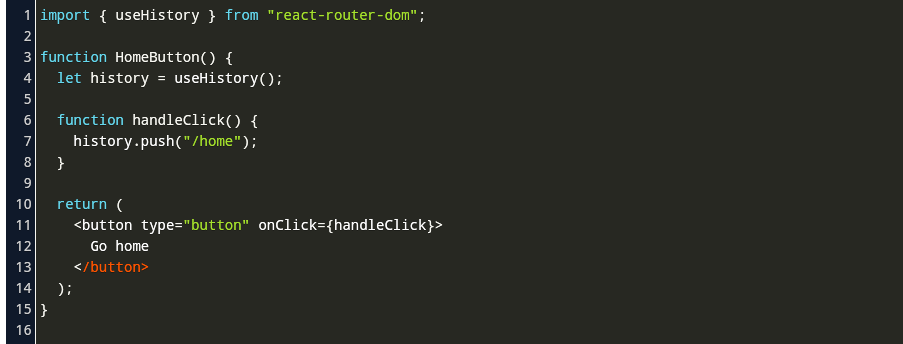
- #React router dom history listen how to#
- #React router dom history listen install#
- #React router dom history listen full#
- #React router dom history listen code#
#React router dom history listen full#
The index.js files in each non-feature folder re-export all of the exports from the folder so they can be imported using only the folder path instead of the full path to each file, and to enable importing multiple modules in a single import (e.g. I prefixed non-feature folders with an underscore _ to group them together and make it easy to distinguish between features and non-features, it also keeps the project folder structure shallow so it's quick to see everything at a glance from the top level and to navigate around the project.
#React router dom history listen code#
Inside the src folder there is a folder per feature (app, home, users) as well as folders for non-feature code that can be shared across different parts of the app (_components, _helpers, _services).
#React router dom history listen install#

Login & Register pages have form for data submission (with support of react-validation library). It gets app state from Redux Store.Then the navbar now can display based on the state. The add and edit buttons navigate to a page containing a Formik form for creating/updating a user record, and the delete button executes a function within the user list component to delete the user record. The App page is a container with React Router. The example app includes a basic home page and users section, the default page in the users section displays a list of all users and includes buttons to add, edit and delete users. The records in the example app are user records, but the same CRUD pattern and code structure could be used to manage any type of data e.g.
#React router dom history listen how to#
This tutorial shows how to build a basic React CRUD application with Formik that includes master and detail views for listing, adding, editing and deleting records from a JSON API. Navigation LinksĪ Link element will navigate to the route specified in the to prop when clicked.Tutorial built with React 16.13.1 and Formik 2.1.4 The matching in Routes is much smarter with precedence based on how specific a the path is with a Route. Routes replaces Switch in previous versions of React Router and a key difference is that the ordering of the Route elements within it don’t impact the matching like it used to do with Switch. Here we are using the React Hooks to manage the scroll position. You can also ignore the routes for scroll to the top as well.


Now let’s create a component as ScrollToTop where we will listen to the history and set window scroll to top on componentDidMount. A few low-level pieces that we use internally are also exposed as public API, in case you need to build your own higher-level interfaces for some reason. Create top level component to manage the scroll. useRoutes if you'd prefer a JavaScript object-based config.
So, the Route element is a bit like an if statement - if its path matches the current path, it renders its element. React Router provides two interfaces for declaring your routes. Whenever the location changes, Routes finds the child Route element that best matches the path prop to the current location and renders the element defined in the element prop. Each route is defined in a Route element within it. BrowserRouter provides information about the current location to its descendants and will perform navigation between pages.Ī set of routes is defined as a Routes element. The BrowserRouter element is usually the topmost element in the component tree because all other React Router elements need to be nested within it.


 0 kommentar(er)
0 kommentar(er)
